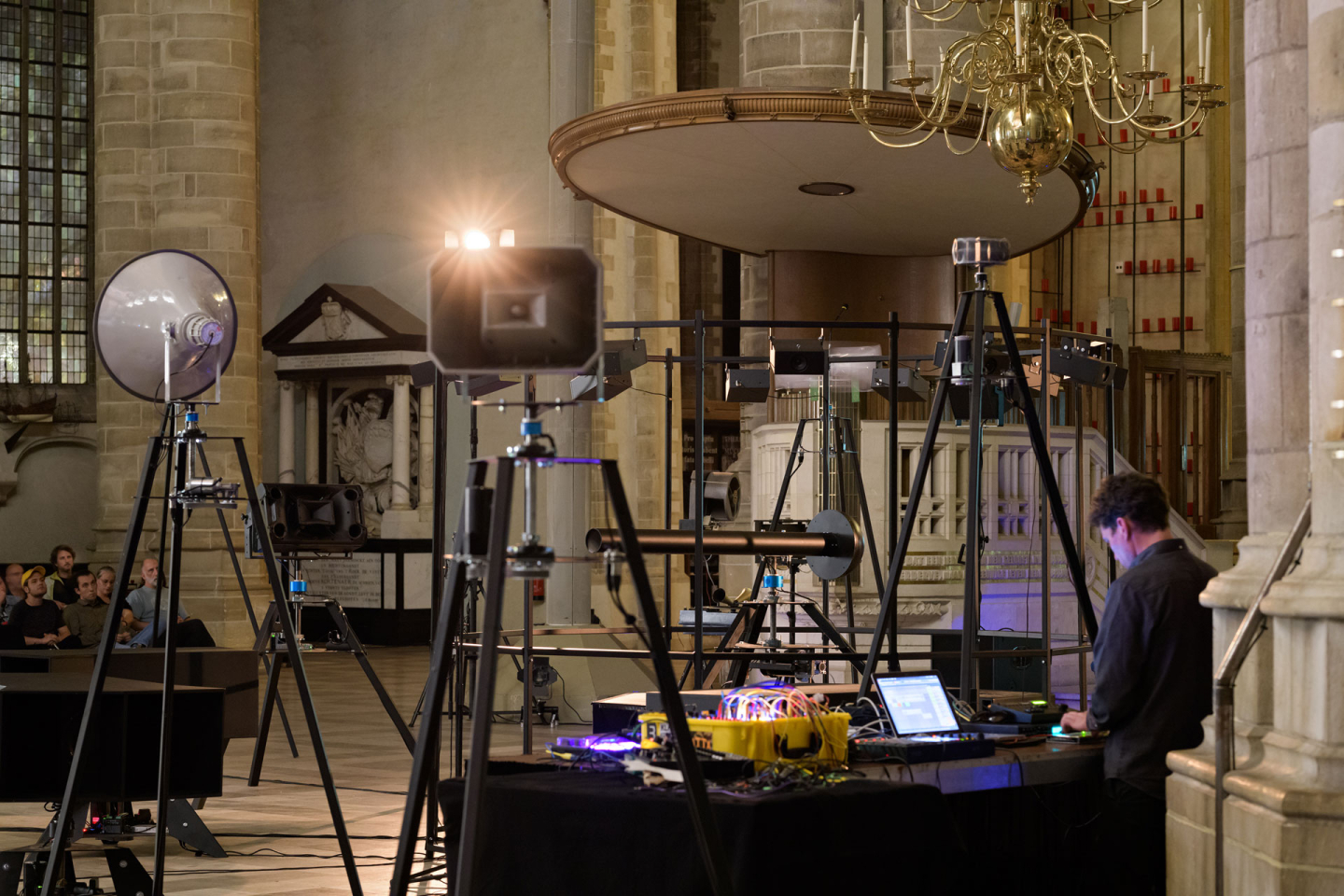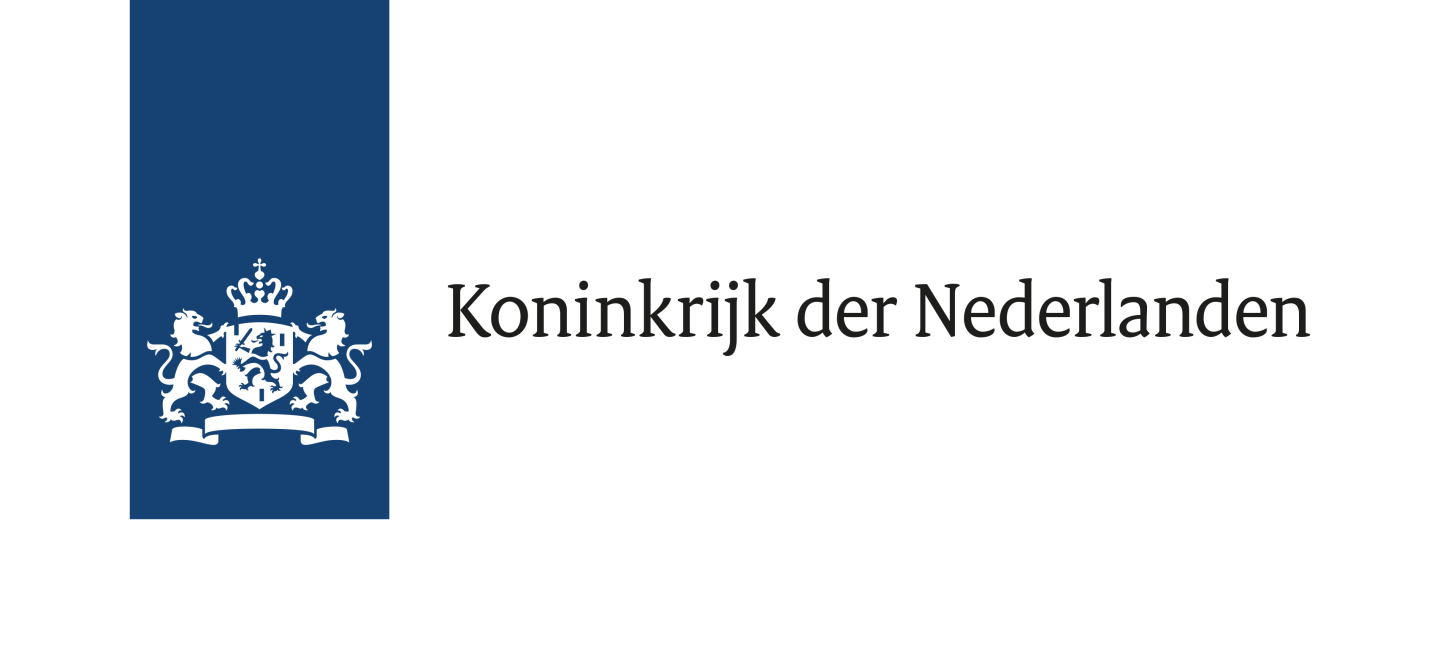Klankvorm presents Kinetic Sounds
.2022 19:30

INTRODUCTION
The ‘Kinetic Sounds’ installation is the physical result of a Klankvorm research project on the topic of sound and movement. The project was realized in close collaboration with the Macular Collective after a long trajectory of experiments in which sound sources were rotated to create an interaction between the sound source and the acoustics of the space. The result of the research trajectory is a custom-built sound system that creates immersive and dynamic fields of sound through rotating sound sources. The physical installation consists of a collection of moving speakers that can be placed in various formations in a room. The different speakers in the system all have their own identity in terms of sound and movement. The sound input is reproduced in different ways by means of resonance tubes and pressure chambers. For example, some speakers only reproduce very high sounds, others focus specifically on the low tones within the sound spectrum.
‘Kinetic Sounds’ can be seen as a mechanical version of an orchestra or as a fully automated ensemble of robotic musicians which all have their own sound, character and movement. Due to the 'open content' character of the installation, makers and artists can compose new sound pieces and live performances for the installation.
The ‘Kinetic Sounds’ installation was realized with the goal of creating a transportable and multi-purpose sound system that can be used at various public events. An important part is the ‘open content’ idea of the installation. Through artist-in-residence periods, makers, musicians and artists are invited to generate new content for the system.
Although ‘Kinetic Sounds’ mainly focuses on the audience's sound experience, the visual character of the collection of speakers has strong relations with, for example, the functional and minimalist architectural style of the ZERO movement and Constructivism. The movement aspect of the work has a strong relationship with the sound thus creating a cinematographic experience, image and sound are directly linked. The choreography performed by the speakers is as much determined by the artist as is the sound that can be heard.
CREDITS
Concept: Daan Johan, Joris Strijbos, Eelco Ottenhof
Realization: Daan Johan, Joris Strijbos, Eelco Ottenhof, Matthijs Munnik, Jeroen Molenaar, Dineke van Oosten, Thijs Kelder.
Kinetic Sounds is a Klankvorm production and made possible with the generous support of Creative Industries Fund NL, Mondriaan Fund and City of Rotterdam.
ARTISTS
Anni Nops
Anni Nöps is a sound artist, electronic composer and DJ based in the Netherlands. Her sonic palette is bold and explorative, comprising hard hitting percussions, floating melodies and tactile noise. Her soundscapes have been likened to musique concrète and New York downtown music. She has performed and presented her sonic works at arebyte gallery (London), FIBER Festival (Amsterdam), Sonic Acts Festival (Amsterdam), Tetem Kunstruimte (Enschede) & Rewire Festival (the Hague) and is recently collaborating with contemporary choreographers at ICK/Veem Amsterdam and Stuttgart Ballet.
Julian Edwardes
Julian Edwardes (UK/NL ‘79) is an artist and electronic musician from the Netherlands.
His work centers around algorithmic ecosystems, pattern- and tone generators, the elegance of code and the movement of sound. Julian is a trained visual artist with a background in Fine Art; he studied at AKV St Joost in Breda and at the Sandberg Institute Amsterdam.
His compositions are akin to his experience in relating to three-dimensional work in a space.
Sonic entities are playfully sculpted and positioned in landscapes of shifting symphonic drone. Form, language, identity and existence are assayed within compositional frameworks pullulated from a modular synthesizer, utilizing unstable systems and disrupted resonant bodies.
He resided at the Willem Twee Studios ‘s-Hertogenbosch, is connected to production house Intro In Situ Maastricht and performs improvised sets on a regular basis.
Presently Julian lives and works in Breda, the Netherlands
Rotor
Rotor is an experimental sound collective which was initiated in 2017 by Eelco Ottenhof and Joris Strijbos. Within the project the duo experiments with performative installations consisting of rotating sound sources, multi speaker setups, feedback systems and modular synthesizers. Their sonic explorations are at the intersection of sound art, dark ambient and noise. Through combining abstract layers of synthetic drones, rhythmical pulsating structures and processed analogue feedback systems, Rotor creates immersive and spatial sound experiences with an emphasis on the acoustics of the space.
Macular
Macular is an initiative of a group of artists who share a collective interest in art, science, technology, and perception. The members of the collective collaborate on the creation and production of multi-sensorial artworks that are presented at media arts festivals, galleries, and other arts institutions around the world. An important part of the initiative is that the collective functions as a nomadic lab in which the members do research and develop the technology and theory that’s needed in order to create their works.
One of the ongoing research topics is the creation and manipulation of emergent systems and the possibilities for composition that arise from them. Besides showing these systems as installations, they can also be seen as instruments for live performance, where the performer and/or the audience becomes part of the system. Another field of interest is the notion of musical thinking and the way concepts of musical theory can be inserted into other media in order to create generative compositions in movement, light, and sound.
In doing so, the artists aim to create their own abstract language that is mostly based on rule-sets within self-built systems. This development happens through constant interaction between the works and the creators. The pieces are shaped and transformed throughout the process. With this in mind, Macular aims for a minimalistic aesthetic through a continuous exploration of the basic characteristic properties of the media they use. Whether they are cultivated systems or natural phenomena, the medium gets stripped down to the essence of the medium itself, showing only what is necessary to perform the composition.
Work by Macular members has been shown worldwide at festivals and institutions such as; Ars Electronica (Linz, AT), WRO International Media Art Biennale (Wroclaw, PL), Saatchi Gallery (London, GB), Taiwan Museum of Fine Arts (Taichung, TW), Boijmans van Beuningen (Rotterdam, NL) Woodstreet Galleries (Pittsburgh, US), AxS Festival (Pasadena, US), Lucida Space NCCA (Moskow, RU), Microwave International New Media Arts Festival (Hong Kong, CN), TodaysArt Festival (Tokyo, JP & The Hague, NL), Ende Tymes IV (Brooklyn, US), New Wight Gallery (Los Angeles, US), DEAF Biennale (Rotterdam, NL), Sonic Acts Festival (Amsterdam, NL), Stedelijk Museum (Amsterdam, NL), Biennale of Carrara (Carrara, IT), Exit Festival (Paris, FR), Van Gogh Museum (Amsterdam, NL), V2_Institute (Rotterdam, NL), ISMAR/SHIFT Festival (Basel, CH), Kontraste Festival (Krems, AT), Sight&Sound Festival (Montréal, CA), and Salone del Mobile (Milan, IT).
Daan Johan
Daan Johan is an artist who explores the technology from the past to create new instruments, often with a form of sculptural value and craftsmanship.
Starting out in graphic design at St. Lucas in Boxtel, he soon got interested in electronic music. After making electronic music for a while, he soon realized that the technology behind the music was of greater interest to him. Since 1997 he’s been exploring the guts of analog synthesizers, lab equipment, and hifi equipment to create unique and often unexplored forms of sound creation. First by means of circuit bending, and later, after some studying and experimenting, by modifying and creating his own mechanical and electronic equipment. Using these techniques together with software, he started creating interactive installations. At the same time he kept on drawing and made his first steps into stop motion animation.
In 2006 he entered the Image & Sound / ArtScience program at the Royal Academy of Art and the Royal Conservatory, where he received his BFA in 2010 and earned his MFA at the Royal Conservatory in The Hague in 2012.
Since then he tries to blur the boundaries between engineers and artists. His main focus is still on creating instruments and installations with the interface as a starting point and making unique instruments for other performing artists.

